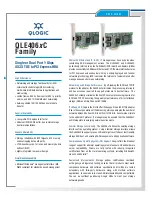
Access Control
IPv4-based ACL Creation
Cisco 350, 350X and 550X Series Managed Switches, Firmware Release 2.4, ver 0.4
405
22
-
Range
—Select a range of TCP/UDP source ports to which the packet is matched.
There are eight different port ranges that can be configured (shared between source
and destination ports). TCP and UDP protocols each have eight port ranges.
•
Destination Port
—Select one of the available values. These are the same as the Source
Port field described above.
NOTE
You must specify the IP protocol for the ACE before you can enter the source
and/or destination port.
•
TCP Flags
—Select one or more TCP flags with which to filter packets. Filtered packets
are either forwarded or dropped. Filtering packets by TCP flags increases packet
control, which increases network security.
•
Type of Service
—The service type of the IP packet.
-
Any
—Any service type
-
DSCP to Match
—Differentiated Serves Code Point (DSCP) to match
-
IP Precedence to match
—IP precedence is a model of TOS (type of service) that the
network uses to help provide the appropriate QoS commitments. This model uses
the 3 most significant bits of the service type byte in the IP header, as described in
RFC 791 and RFC 1349.
•
ICMP
—If the IP protocol of the ACL is ICMP, select the ICMP message type used for
filtering purposes. Either select the message type by name or enter the message type
number:
-
Any
—All message types are accepted.
-
Select from list
—Select message type by name.
-
ICMP Type to match
—Number of message type to be used for filtering purposes.
•
ICMP Code
—The ICMP messages can have a code field that indicates how to handle
the message. Select one of the following options to configure whether to filter on this
code:
-
Any
—Accept all codes.
-
User Defined
—Enter an ICMP code for filtering purposes.
•
IGMP
—If the ACL is based on IGMP, select the IGMP message type to be used for
filtering purposes. Either select the message type by name or enter the message type
number:
-
Any
—All message types are accepted.
-
Select from list
—Select message type by name.
















































